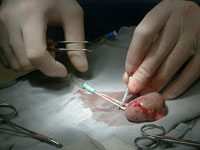
APPROACH TO TIMING OF FELINE KIDNEY TRANSPLANTS AT THE UNIVERSITY OF WISCONSIN
 |
| A kidney is flushed out prior to cold storage for transplant in a recipient with chronic renal failure. |
We will perform a kidney transplant on a cat with chronic renal failure if:
- the cat has had an appropriate diagnosis of chronic renal failure; and either:
- the serum creatinine values are sufficiently elevated so that postoperative function of the transplanted kidney can be assessed; or
- the patient exhibits signs of decompensation.
In practical terms, this means we would prefer to transplant cats with serum creatinine values of 4.0 mg/dl or higher. However, cats with serum creatinine values less than 4.0 mg/dl would be considered if they had difficulty in maintaining themselves (food, hydration), were dependent on subcutaneous fluids, or had developed a significant secondary problem related to the kidney failure (anemia is one of the most common and earliest sequelae to occur). Most cats presented for transplant exceed these guidelines by a wide margin.
Cats that have mildly elevated serum creatinines (less than 3.5 mg/dl) and other general sequelae that could be related to chronic renal failure, such as ill health or poor quality of life, may indeed benefit from a kidney transplant. However, many of these patients are ill because of undiscovered or misdiagnosed diseases that are unrelated to chronic renal failure. A cat with clinical signs (general illness) that are not consistent with the level of kidney failure indicated by serum creatinine or other measurements (ie. the creatinine is too low to be consistent with its condition), needs to be evaluated very carefully before a transplant is to be considered.
As with any general guidelines, individual circumstances may dictate altering this approach for specific patients. If you have questions it is best to call and ask.
It is important to remember: Kidney transplantation is not an emergency treatment to attempt salvage of the critically ill patient. Patients presented for transplant in the terminal phase of renal failure have a poor prognosis for success or even survival through the surgery. It can take some time to organize the work-up, obtain and evaluate a kidney donor and prepare the recipient for surgery. A week is generally a minimum. It can take longer depending on donor availability and matching with the recipient. A patient presented in a terminal condition often does not survive until the surgery can be arranged. It behooves the owner of a cat with chronic renal failure to plan ahead.
For information on selection criteria for appropriate candidates for kidney transplantation, go to SELECTION OF CANDIDATES FOR KIDNEY TRANSPLANTATION AT THE UNIVERSITY OF WISCONSIN.